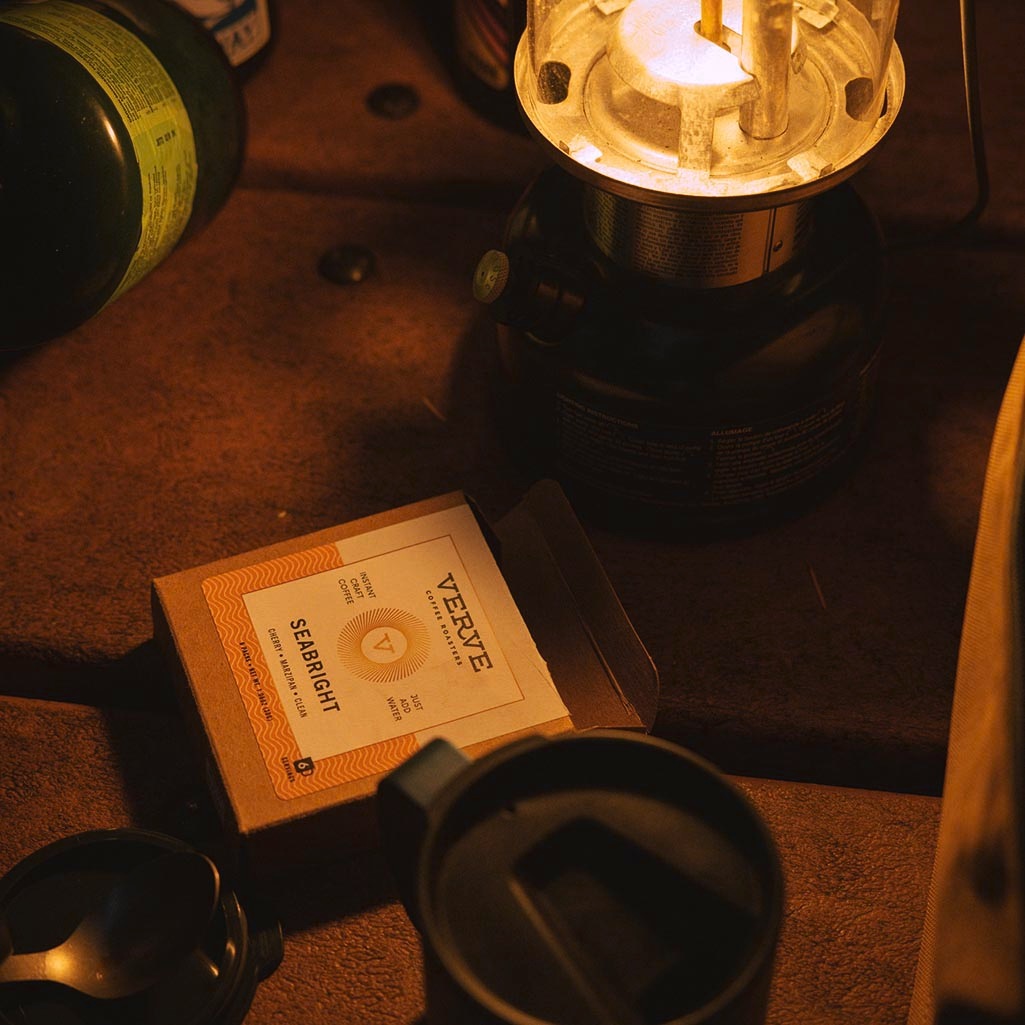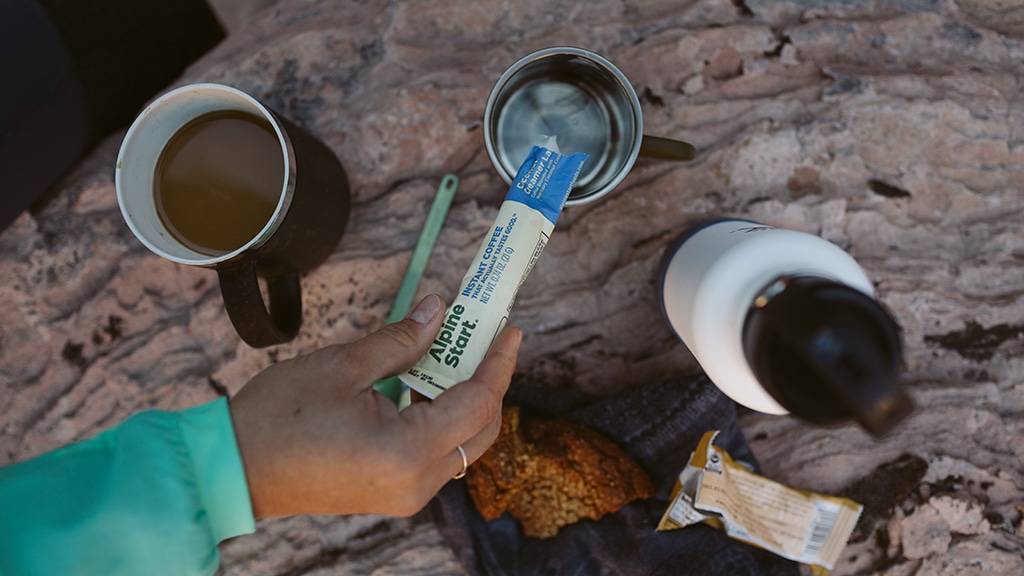Summer; Mount Zirkel Wilderness, Colorado. It’s a little after 8am on a drizzly, see-your-breath morning in the backcountry, and the water in the Jetboil is bubbling. I dump a sachet of dark-brown granules into my camp cup, add the water and, presto, my coffee is ready. Eyeing the grumpy clouds building on the horizon, I unzip the tent flap—careful not to jostle my precious, steaming cargo—and scuttle into the tent to join my friend and our boys as they set up a game of Uno. A moment later, the husbands clamber in with their own mugs of instant heaven, plus a pile of slightly charred blueberry pancakes. Inside the tent, it’s chilly, wet and—thanks to three elementary schoolers yelling, “Draw four!” with their mouths full—totally chaotic. But as the mug warms my fingers and I sip impressively tasty instant coffee among people and mountains I love, I grin: There’s nowhere I’d rather be.
Reflecting on that scene now, the people and place stand out of course, but so does the coffee—the way it smelled, tasted, delighted, and generally elevated the entire experience. My instant cup was simple to brew. The sachet added mere ounces to my pack weight. The caffeine hit wasn’t essential, but it did put an extra spring in my step. And despite the bad rap instant coffee has gotten (perhaps rightfully so) for tasting weak, stale or burnt, my backcountry cup tasted remarkably similar to the mug of specialty coffee I measure, grind fresh and AeroPress each morning at home.
These days, there are more and more tasty instant coffee options for anyone who prefers their joe with a side of nature. And some companies, like Alpine Start and Kuju Coffee—both founded by adventures—are catering to fellow outdoorspeople who want high-quality caffeine without the extra pack weight.
So how did we get to this place where coffee—truly good coffee—was so accessible in a place so remote? I turned to the experts to find out.

How Instant Coffee Is Made
Instant coffee—also known as soluble coffee—is the term used to describe granules of dehydrated brewed coffee that have been preserved in packaging and easily dissolve in liquid, typically water or milk for a cup of coffee in mere moments. Comparatively, roasted coffee whole-beans require grinding and brewing before they can be drunk, which can take several minutes.
But first, let’s back up with a little Coffee 101, because in the early stages, the process for creating instant coffee is the same as the process for whole-bean coffee.
Coffee beans are the seeds of a cherry-like fruit that grows on bushy plants found on farms (and sometimes in the wild) between the tropics of Cancer and Capricorn. In most coffee-producing countries, the labor-intensive process of harvesting these cherries is done by hand.
Inside the cherry are two seeds or “beans,” typically side-by-side. After picking, these beans are removed from the fruit, dried and sorted for quality. (“Specialty coffee” commonly refers to coffees that meet higher quality standards throughout this process.) Finally, the beans—now referred to as “green” or unroasted coffee—are exported and sold to a roaster.
After the roasting stage is where the process for instant coffee differs from that of whole-bean coffee. While whole-bean roasted coffee is simply bagged up and sold to consumers or cafés, coffees destined to become instant are ground up and brewed with water to create a concentrated extract. The extract is then either freeze-dried to around -40°F, broken into granules and sublimated; or spray-dried into granules by moisture-removing, high-temperature air. When you stir a scoop of instant coffee granules into your favorite thermos and mix them with hot water, they dissolve and are diluted from their concentrated state, creating a drink that (ideally) tastes fresh-brewed—and no leftover grounds to clean up.
The concept of instant coffee is old—like, really old. “The idea of drying food to make it last longer is as old as time,” says Peter Giuliano, executive director of the Coffee Science Foundation and chief research officer of the Specialty Coffee Association, a nonprofit trade organization that promotes specialty coffee in the United States and Europe.
While the technology to dehydrate beverages into an “instant” mix arose during the Industrial Revolution, instant coffee’s popularity really took off during World War I, when American soldiers received it as part of their rations. The stimulating caffeine and comfort of a hot beverage were important morale boosters. “When you’re a little bit under-temperature and you’re sleepy, coffee is the best thing ever,” says Giuliano. “Outdoorspeople know this better than anyone.”

From Convenience to Quality
Instant coffee was one of many modern conveniences that saw further advancement—or at least modification—during World War II. Like TV dinners, Tang, boxed cake mixes and other whiz-bang “techno” food products of the 1950s, instant coffee was repurposed (and touted by advertisers) as another low-cost time-saver.
Taste, however, was secondary. Giuliano says that back then, coffee beans in general were of poorer quality—due to factors like lousy weather, political unrest and lack of supportive infrastructure for farmers—and soluble-coffee manufacturers took added shortcuts in the process of extracting and dehydrating. “If you’re aiming for cheapness, then you tend not to be careful,” he adds. “It just created a not-great flavored product.”
In other words, instant coffee came by its bad reputation honestly.
After all, few things can be cheap, fast and good—you have to pick two. For most of its history, instant coffee cost very little and took no time at all—at the expense of flavor. But by the late 1960s, a branch of the coffee industry was transitioning back to a taste-first mentality, buying high-quality beans (with a higher price paid to the farmer) and roasting in small batches.
“Being more intentional about choosing the kind of coffee that you’re going to brew before you make instant coffee out of it,” Giuliano says, “made a big difference in the product.”
Coffee-drinkers followed suit: By the mid-‘90s, more people were appreciating coffee beverages like lattes and cappuccinos that took time and care to create. Today, 43% of coffee-drinking Americans opt for higher-quality specialty coffee. And it was only a matter of time before that pursuit of quality came for instant coffee—and outdoorsy people rejoiced.

The Nature of Instant Coffee
Today, specialty instant coffee manufacturers intentionally source high-quality green coffee and transport it with more care. That means taking steps to preserve the beans’ freshness, protecting them from exhaust fumes and shielding them from direct sunlight. “You’re talking about a crop,” says Matt Tilley, head of coffee at Verve Coffee Roasters, a California-based specialty coffee roaster whose instant coffee is available at REI. “You wouldn’t want your carrots or cabbage … to be set out on long distances, exposed to environmental factors. It’s the same with your coffee.” Some coffee companies, like Verve, also develop direct partnerships with coffee farmers to improve quality and increase supply chain equity. Others, like climate-neutral-certified Alpine Start, focus on environmental initiatives like donating to Protect our Winters through 1% For the Planet.
Once the green coffee is in the hands of the coffee roaster, they determine how best to bring out that specific bean’s optimal flavor profile based on professional sensory analysis. It’s a true craft, Giuliano says, noting that these artisans not only decide how dark to roast the beans but also how to achieve that darkness, for example by roasting at a constant temperature or starting cooler and then pouring on the heat at the end of the process. “A typical specialty roaster will put a lot of energy into trying to figure out what the ideal roast parameters are to accentuate the flavors that they want in the coffee,” Giuliano adds. “That’s what specialty coffee roasting is all about.”
After roasting, the coffee beans are transformed into instant coffee using the same tried-and-true methods developed more than a century ago: freeze-drying or spray-drying. In both cases, the result is just-add-water-ready coffee, a product ideal for backpackers, climbers and anyone else who wants to wake up to a quality cup of java away from the comforts of home.
“There’s no mess. There’s no fuss,” says Matt Segal, a professional climber and founder of instant coffee brand Alpine Start. The idea for an instant-coffee company came to Segal while he was on a climbing expedition: Disappointed by having to drink subpar java every morning, he set out to make something that was delicious and easy to bring along for the trek. “It’s one-handed coffee. You don’t need another device. You just need water.” Well, that and a mug, of course.
Starting the morning in a tent with a hand-warming cup of (good-tasting) instant is my personal definition of basecamp bliss. But if hot water is hard to come by—or if you’re adventuring in the desert and a steaming cuppa is about as appealing as a scorpion in your sleeping bag—many instant coffees dissolve with room-temperature or even cold water for a quick on-the-go pick-me-up.

Another popular backcountry coffee brand, Kuju Coffee similarly makes caffeine delivery systems that just require water. Its claim to fame are individual, specialty-coffee-filled packets that are ready-to-brew rather than soluble: Kuju single-serve pour-over coffee anchors to a camp mug to facilitate a manual, drip-brewing process, while its Summit Steeper pouches brew by steeping, like a traditional tea bag. Kuju CEO and co-founder Jeff Wiguna likes the way these brewing methods allow people to take a minute to appreciate the ritual of the brewing process. It’s like “making the outdoors your personal café,” he says.
Get Outside with Instant Coffee
Regardless of how meditative or, well, instant, the format, coffee’s overall appeal is strong—and growing. Nia Castro, the REI buyer for nutrition and wellness products, reports that instant coffee sales increased from roughly 25,000 units in 2015 to nearly 70,000 in 2022. It makes sense that coffee would be popular among backcountry adventures, Castro says. “It gives you that homey feeling, [even] while you’re out doing an activity.”
More and more REI Co-op Members are indicaing that they appreciate good coffee just about as much as they love waking up in the backcountry. And now—thanks to the small size of instant coffee packets and how quick and simple they are to brew—it’s easier than ever to experience both of these perks at the same time.
Specialty instant coffee “has come back into the fold as a legitimate, delicious coffee ingredient,” says the Specialty Coffee Association’s Giuliano. It’s “a useful part of a discerning coffee drinker’s arsenal.” Fondly remembering my own experience with instant coffee elevating my time in the Colorado mountains, I’m inclined to agree.
Has instant become the 11th essential? Probably not, but you’d better believe it’s earned a spot in my backpack from now on.

